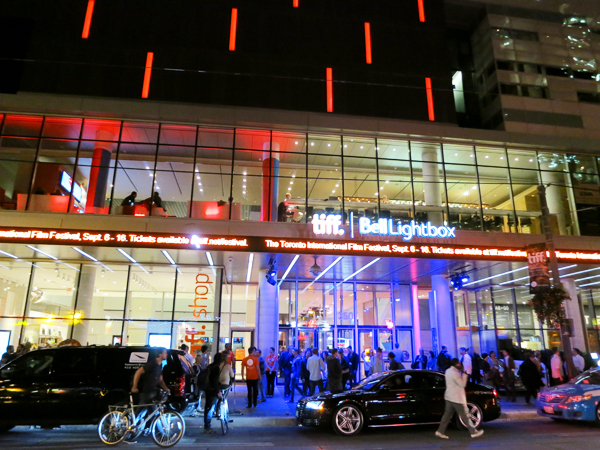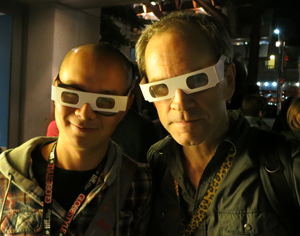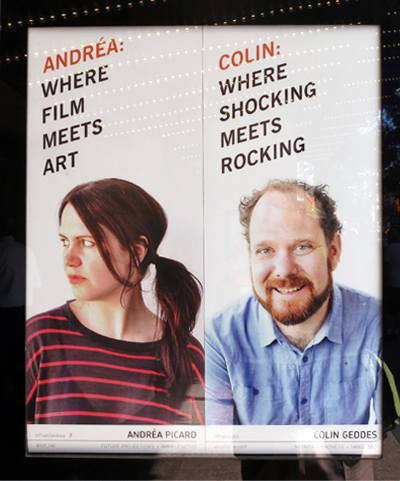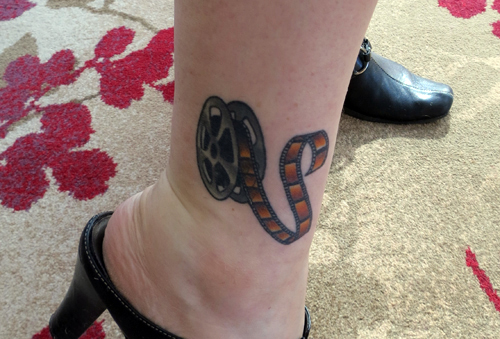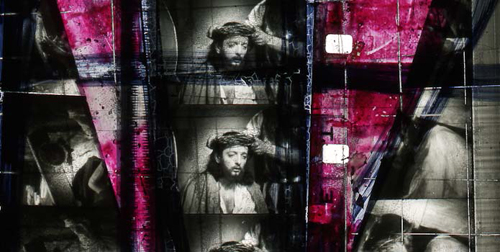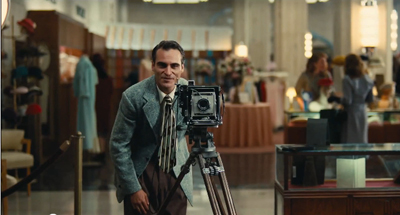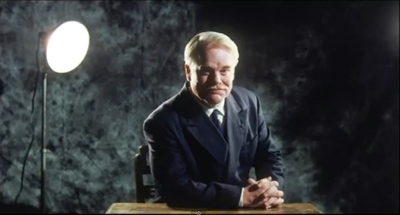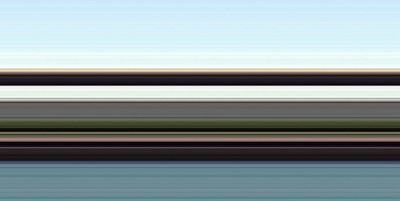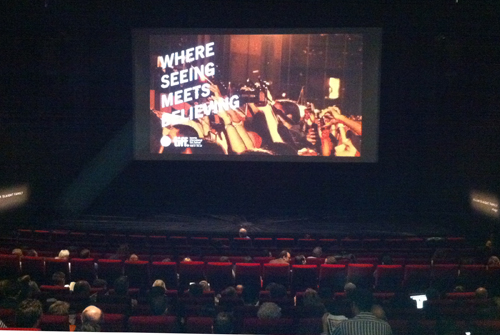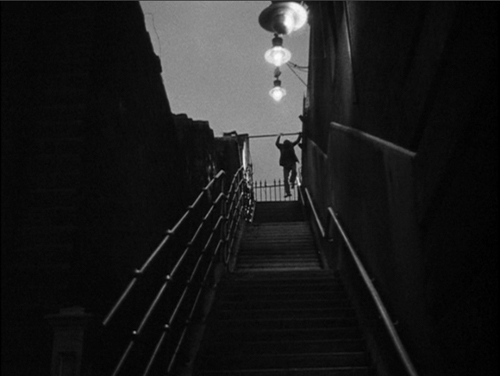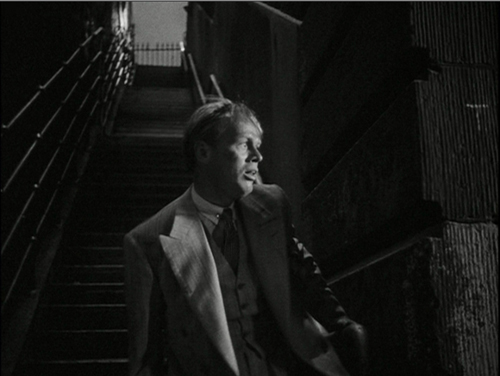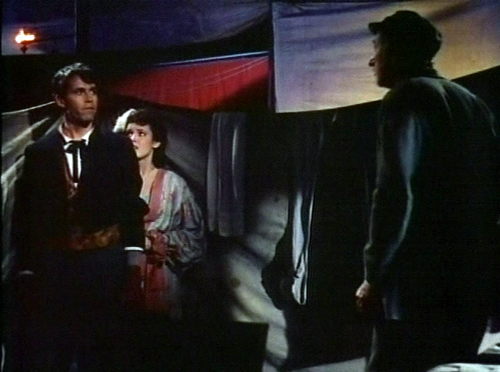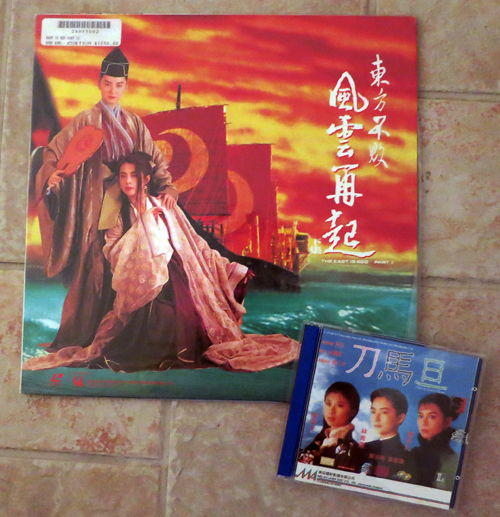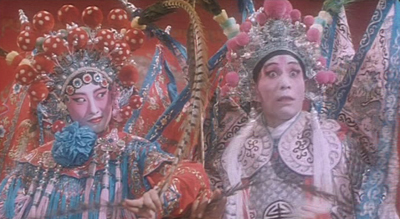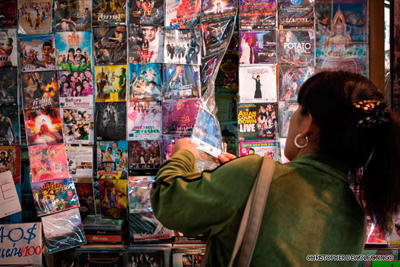Archive for the 'National cinemas: China' Category
TIFF: More than movies
Audiences gather for screenings at the Bell Lightbox, hub of the Toronto International Film Festival.
DB here:
Around midnight tonight, the crowds packing the Toronto International Film Festival will disperse, leaving the city full of memories of another extraordinary year. I’ve been back in Madison for this last week, but my few days at TIFF remain on my mind. This is partly because along with the films came a lot of ideas, opinions, and information. At any festival, fraternizing with audiences, critics, and programmers is one fine way to get that stimulation. It happened after some of the Wavelengths section’s short-film programs. Here are Raymond Phatanavirangoon and Bob Koehler outside the Art Gallery of Toronto, where their Devo retro-stylings raised our conversation to a new level.
More structured sessions delivered too. Out of my 4-plus days at the Toronto International Film Festival, I set aside about one and a half for industry panels and filmmaker Q & A’s. Let me tell you a little of what I learned.
From Assayas to Asia
TIFF: Where programmers meet stardom.
The talkfests I attended shed light on both film artistry and film business-making. Central to the first area was the master class with Olivier Assayas, hosted by Brad Deane.
Assayas, a charming fellow, talked fluently about how Something in the Air (discussed here) bears traces of his youth. During the 1970s, high-school kids were “footsoldiers of the cultural war of the time.” He recalled his affinities with the artistic side of the counterculture, as opposed to the extremes of the political activists, some of whom, being aligned with Maoism, refused to recognize the Cultural Revolution as “disaster on a demented level.” Yet this shouldn’t be taken as apolitical aestheticism; Assayas has been a vigorous advocate for the work of Situationist Guy Debord.
 Assayas was refreshingly detailed about his working methods. He writes only one draft of his screenplay, partly because he wants to protect the “digressive” aspects of his story. (This tendency is apparent, and enjoyable, in Something in the Air.) Since his films are difficult to classify within standard genres, he needs to cobble together creative financing for each project. But the script becomes obsolete when he casts the film and visits locations. By embodying the characters, the actors create beings “more powerful than what I’ve written.” Working with them, he refuses to supply background on the characters’ psychology. “I look to them to understand the characters.” This hands-off approach yields striking results in the new film, where nearly all the cast is non-professional.
Assayas was refreshingly detailed about his working methods. He writes only one draft of his screenplay, partly because he wants to protect the “digressive” aspects of his story. (This tendency is apparent, and enjoyable, in Something in the Air.) Since his films are difficult to classify within standard genres, he needs to cobble together creative financing for each project. But the script becomes obsolete when he casts the film and visits locations. By embodying the characters, the actors create beings “more powerful than what I’ve written.” Working with them, he refuses to supply background on the characters’ psychology. “I look to them to understand the characters.” This hands-off approach yields striking results in the new film, where nearly all the cast is non-professional.
Assayas doesn’t undertake elaborate rehearsals, instead coming to the set each morning and describing the shots they’ll make. He wants to take account of the evolution of the film as it’s been developing. He doesn’t fully block the shots. He sketches each one in longish takes that, as the actors expand on the action, “add layers” to what he’d initially planned. Alternatively, he cuts up the long takes and combines pieces of them. For Something in the Air, he relied on stable and wide framings, partly in reaction to trends toward handheld shots and close-ups, partly because he used the crane to create a “floating,” more lyrical circulation through the space.
 Artistry, mixed with business sense, was apparent in one of the panels at the Asian Film Summit’s day of meetings. Colin Geddes hosted a session on Asian genre cinema, and several producers and directors shared thoughts on action cinema as an international genre. Fanboy blood pulsed high.
Artistry, mixed with business sense, was apparent in one of the panels at the Asian Film Summit’s day of meetings. Colin Geddes hosted a session on Asian genre cinema, and several producers and directors shared thoughts on action cinema as an international genre. Fanboy blood pulsed high.
Eli Roth (left), another kid who grew up with Kung-Fu Theatre on TV, was bowled over years later by Korean and Japanese thrillers like Sympathy for Mr. Vengeance. Now Roth is producer and co-writer of The Man with the Iron Fist, directed by RZA–who is, according to Roth, letter-perfect on his kung-fu film knowledge. “We wanted to do a movie like we saw as kids on Saturday afternoon.” But production values in the genre have swollen since the old days. The project is using the Hengtian studio’s vast replica of the Forbidden City. RZA, Roth says, expected The Last Emperor to be a kung-fu movie, so this is his attempt to make things right.
Tom Quinn, Co-President of the Weinstein Company’s RADiUS division, had similar affinities. As he pointed out, East Asian countries have strong local markets and so can build a base in genre cinema. With quantity comes quality. While working at Goldwyn and Magnolia, Quinn handled US distribution for The Host, Pulse, Tears of the Black Tiger, and most recently 13 Assassins, along with many other titles. Ong-Bak, on view at TIFF in 2004, was a particular triumph for him, yielding over a million dollars in its first weekend of release and eventually garnering $4.5 million in the US. Even the heavy piracy of Ong-Bak Quinn takes as a positive sign, “a validation of the film’s value.”
Bill Kong, a legendary Hong Kong producer and a force behind Crouching Tiger, Hidden Dragon, along with Stephen Fung, director of Tai Chi 0 (above), filled out the panel. Overall, the discussion ranged widely, but one question kept cropping up. Why is it that Western films are widely popular in Asia, but Asian cinema is almost completely a niche market in the West? I didn’t hear a clear answer (though I’d start an answer with Western racial prejudice).
Kong noted that Asian filmmakers don’t have high expectations about penetrating the US market, but other panelists were more hopeful about crossover projects. Quinn pointed out that the festival circuit built an audience, and Roth thinks that Tarantino has been a major player in making Asian film more popular, especially with the Kill Bill duet. The fact that Russell Crowe plays a major part in The Man with the Iron Fist suggests that things may be changing.
Bigger than Bollywood
Mira Nair.
The East/West dynamic was also the focus of two other panels. “India: Lessons from Bollywood and the Independents” brought together a nearly all-female group of experts to discuss local financing and wider distribution. All were agreed that it was necessary to convince the world that Indian cinema was bigger than Bollywood. As director Dibakar Banarjee put it: “We need to open the third eye.”
The local industry has a certain comfortable inertia. A film might cost only $150,000, but it can collect 90% of its production costs upon its opening run, said Shailja Gupta, who has been both a director and production executive. Foreign distribution is a major risk at this budget level. So how does a project, particularly an independent film, get international traction?
Coproductions are an obvious path, and while they are still rare, the trend is emerging. The Indian government’s National Film Development Corporation Ltd. has helped with coproductions since 2006, says Nina Lath Gupta, NDFC Managing Director. Such enterprises are rare and mostly involve France or Germany. By establishing the Film Bazaar in 2007, the NDFC acknowledged the importance of marketing as well as financing, and this is getting local filmmakers acquainted with the need to think more globally.
 Another path to the overseas market was suggested by Guneet Monga (right). She is a producer on the network narrative Peddlers and the two-part gangster saga Gangs of Wasseypur; both earned very good buzz at TIFF. Monga pointed out that sales agents can help shape projects for international distribution.Working with Elle Driver, she was able to generate three versions of Gangs, targeted for different regions. Moreover, sales agents can help a film by avoiding the old practice of selling it as a single package. Instead, the agent can pre-sell it with a minimum guarantee and negotiate territorial rights further down the line.
Another path to the overseas market was suggested by Guneet Monga (right). She is a producer on the network narrative Peddlers and the two-part gangster saga Gangs of Wasseypur; both earned very good buzz at TIFF. Monga pointed out that sales agents can help shape projects for international distribution.Working with Elle Driver, she was able to generate three versions of Gangs, targeted for different regions. Moreover, sales agents can help a film by avoiding the old practice of selling it as a single package. Instead, the agent can pre-sell it with a minimum guarantee and negotiate territorial rights further down the line.
Mira Nair, distinguished director of Salaam Bombay and Monsoon Wedding, has long enjoyed worldwide exposure, of course. She shared her thoughts on how filmmakers could follow their visions and still, as she put it, “put bums on seats.” That’s accomplished by not worrying about distribution but devoting energies to creative choices–such as she undertook in The Reluctant Fundamentalist, her first foray into the thriller genre.
During the India panel, moderator Meenakshi Shedde asked if China might become a coproduction partner for local films. This is currently not happening, but the question reflects the significance of the People’s Republic on the global film scene. Earlier in the day, a panel on “Financing Between Asia and the West,” moderated by Patrick Frater, concentrated mostly on China as the leading edge of the region. Once more, the question of coproductions was central.
“Coproduction is a reality now for global filmmaking,” declared Peter Shiao, CEO of Orb Media Group. But the power of China in the new media landscape has created a false optimism among Western entrepreneurs. Shiao warned newcomers that coproductions can’t be fulfilled in good faith with perfunctory gestures, such as including a Chinese actor in a secondary role. (The Expendables 2 was mentioned in this connection.) Aspiring filmmakers need to grasp and follow the China Coproduction Film Office regulations straightforwardly.
Solid coproductions are rare, agreed Bruno Wu, founder and chair of many top Chinese media groups. He pointed out that what works in China won’t necessarily work in the rest of the world, but what works in the rest of the world is likely to work in China. So the Chinese investor needs to look at projects that will play internationally. He gave as examples his firms’ deals with Justin Lin and John Woo, who have reliably won global audiences. Along similar lines, Stuart Ford, founder and CEO of IM Global, suggested that a good alternative to coproduction involves soliciting equity investment from China for Western films. For example, Chinese investors in Paranoia, a $40 million production, acquired mainland distribution rights as part of the deal.
The soundness of investing in Western films seems borne out by local box-office figures. Seventy percent of China’s market receipts come from English-language imports; the several hundred domestic films produced earn only twenty percent. And theatrical receipts provide, according to Peter Shiao, ninety percent of a film’s earnings. Windows in the Western sense don’t exist, and there’s no legitimate home video market. Gradually local filmmakers are experimenting with Western ancillary tactics; Painted Skin: The Resurrection recently tried out apps and games.
China-based Video on Demand is more promising. In a few years, Wu expects there to be several million addressable HD cable homes, and providing entertainment on demand might provide a way around the national quota system for film import. There is no quota restraining VOD distribution, and as it takes hold, it might reduce piracy.
A killer app? (as in killing off business?)
Jonathan Sehring and Winnie Lau at the VOD panel at TIFF, 9 September 2012.
Speaking of VOD, in early September I signed up. I did it partly because there was one title I needed to see immediately: Keanu Reeves’ Side by Side, the documentary about the digital vs. film controversy. More abstractly, I had been learning a little about VOD when I recast and expanded my blogs on digital exhibition for Pandora’s Digital Box, and I was curious about how VOD worked in practice.
After a period of turmoil, the US film industry has integrated VOD into its system of non-theatrical ancillaries. Before, we had DVD and Blu-ray, both rental and retail, along with movie channels like HBO and Sundance available on subscription cable. Eventually movies would show up on basic-cable channels. There was also “pay per view” via cable, a one-off transaction now known as Pay TV VOD.
Now, the internet has expanded the options.
*Electronic Sell-Through (EST) allows the consumer to download a film and own it. This service is available through iTunes, Amazon, and other outlets.
*iVOD (internet VOD) is a one-off rental, to be run immediately or within a specified time period. To check the 1.77 aspect ratio on Dial M for Murder, I rented it for 24 hours on iTunes.
*Subscription VOD (SVOD), which you get with Netflix, Hulu, Amazon, and other providers. This option provides a library of titles available at any time for a monthly fee. SVOD is comparable to cable-television subscriptions, and it’s becoming very popular, as all-you-can-eat options tend to be.
In addition, another option hovers over the business:
*Premium VOD (PVOD) consists of a one-off rental available sooner than the traditional home-video window. The transmission would be via cable or satellite, not the Net, and the price point has typically been $30 for one viewing. The studios tried out PVOD with DirecTV in 2011, with apparently unencouraging results. Worse, last year’s Tower Heist fracas, during which Universal planned to put the film on PVOD 30 days after theatrical release, triggered threats of boycotts from exhibitors. PVOD, however, is likely to reappear at some point because it can offset losses from the declining DVD market.
No surprise, then, that one industry panel was called “VOD Killed the DVD Star.” The session assembled major players in that domain to discuss the present situation and the prospects for the future.
Much of the panel’s time was devoted to explaining why filmmakers needed to be flexible about accepting VOD as a legitimate complement to or substitute for theatrical release. VOD, they insisted, shouldn’t be seen as a dumping ground for weak or narrow-interest films. The reason: The consumer is king, and consumers want everything on demand.
Winnie Lau, Executive Vice-President for Sales and Acquisitions at Fortissimo, said that companies now recognized that consumers should be able to see a film on whatever platform they want. Given the high costs of a theatrical release, that option isn’t justifiable for many films. Philip Knatchbull, CEO of Curzon Artificial Eye, put the case more strongly, declaring that with the consumer in control, notions like windows and “on demand” are losing their usefulness. His view suits a company that, like IFC, has integrated video and theatrical distribution with theatre ownership and HD delivery. There are, he suggested, only home cinema and public cinema, and everyone in the film value chain should be aiming to reach millions of screens.
Tom Quinn of RADiUS was working for Magnolia when in 2005 Mark Cuban experimented with a multiple-platform release of Bubble. “His vision,” Quinn recalled, “was to make films available whenever people liked.” The Bubble experiment was problematic because it came out on film and on DVD simultaneously, but Quinn said that “the hotel VOD numbers were through the roof.” This summer, after twelve months of preparation, RADiUS has issued its first VOD titles, and Bachelorette, released earlier in September, won notice for earning about half a million dollars in its first weekend.
 The prototype of longer-term VOD success is the later career of Edward Burns. Burns, who had his first success with the breakout indie movie The Brothers McMullen (1995), was lively and articulate. “VOD helped me stay in business.” He knew firsthand the slow rollout that characterized 35mm platform release in the 1990s, along with the months of press tours. In the years that followed, he realized that his movies–basically, as he put it, people bullshitting with one another around a kitchen table–had shrinking theatrical prospects. In 2007, he offered Purple Violets exclusively on iTunes. This came around the time that IFC and Magnolia were experimenting with day-and-date releasing on different platforms.
The prototype of longer-term VOD success is the later career of Edward Burns. Burns, who had his first success with the breakout indie movie The Brothers McMullen (1995), was lively and articulate. “VOD helped me stay in business.” He knew firsthand the slow rollout that characterized 35mm platform release in the 1990s, along with the months of press tours. In the years that followed, he realized that his movies–basically, as he put it, people bullshitting with one another around a kitchen table–had shrinking theatrical prospects. In 2007, he offered Purple Violets exclusively on iTunes. This came around the time that IFC and Magnolia were experimenting with day-and-date releasing on different platforms.
Burns was satisfied with the results and built a production model around VOD. The cast and crew work for free and collectively own the film. Budgets can be low; he claimed last year that Newlyweds cost only $100,000. Payments are deferred, and if a film breaks through, everyone makes money. His last three films, he reported, did. He compared the business model to that of an indie band. VOD gets his work to the people who watch HBO, Showtime, AMC. “That’s our audience.”
Burns is an unusual instance, since as one panelist pointed out, he has established his own brand. Still, other VOD releases can break out. The most widely publicized example is Margin Call, with about $4.5 million on VOD. Jonathan Sehring, President of IFC and Sundance Selects, was a pioneer of alternative platforms, and he remarked that 4 Months, 3 Weeks, and 2 Days did better on VOD than in theatrical release (where it grossed $1.2 million). In a recent interview, Sehring indicates that the recent IFC release About Cherry as doing as well as Bachelorette on VOD and other revenue streams.
It seems, then, that these and other industry decision-makers see VOD as offering two avenues, depending on the film. VOD can provide a new window, to be added before or after or during theatrical release. Alternatively, VOD can replace theatrical, as it has done for Burns (who will still occasionally give a film like the upcoming Fitzgerald Family Christmas brief theatrical play). With this option, many films, both domestic and imported, will never see a theatrical release but they might make money on the less costly VOD platform.

The problem for the second strategy is finding a way to make the film stand out from the thousands of titles available in cable and VOD libraries. A theatrical release provides the “shop window,” as Knatchbull called it, but without that, the film needs other salient features–big stars or cult buzz–to attract the home viewer.
Despite the panel’s title, the guests didn’t predict that VOD would displace discs. In fact a couple of panelists agreed that DVD and Blu-ray would be around quite a while. Quinn (left) confessed that as someone who grew up with VHS he would always be collecting his favorite films on physical media.
There’s something else to consider: some dramatic disparities between VOD and DVD consumption. The differences are spelled out in a recent IHS Screen Digest report.
On one hand, the VOD audience has grown rapidly. The report counted transactions–buying a movie in any form–and came up with striking figures for the world’s top five regions.
2007: DVD retail and rental: 2.7 billion transactions; online VOD in all forms: 14.8 million transactions.
2011: DVD retail and rental: 2.58 billion transactions; online VOD in all forms: 1.4 billion transactions (nearly all SVOD).
The Screen Digest team estimates that 2012 will see an even bigger burst in online VOD, totaling 3.4 billion transactions, with nearly all that via subscription. (I’m in there somewhere.) By contrast, physical media sales and rentals are predicted to fall further, to 2.4 billion transactions.
The disparity lies in “monetization.” We have some access to weekend box office grosses, but almost none to income from DVD and VOD, so comparison is difficult. Still, everyone knows that DVD purchase and rental, along with pay TV licensing, yield the bulk of film revenues. In another research report, Screen Digest estimates that in the US the 2012 surge in VOD will yield only $1.72 billion. DVD will yield $11.1 billion, nearly ten times the VOD transactions. Even with the declining retail and rental prices of discs, VOD yields much less per transaction than DVD does, especially with subscription services leveling out the cost to consumers.
So did VOD kill, or at least wound, the DVD star? When measured in transactions, yes. In revenues, no. Moguls pay off their Ferraris in dollars, not transactions, so it seems that VOD would have to expand colossally, or raise prices, or both, to come close to achieving the returns of DVD.
It’s conceivable that VOD will cannibalize other windows, if you’ll excuse the mixed metaphor. DVD transactions were going downhill before the rise of VOD, but perhaps VOD will accelerate that plunge. iTunes already charges up to $20 for EST downloads of a new release. As consumers become used to storing their movie and TV collections digitally, the convenience of EST could hurt DVD sales.
Moreover, VOD has always threatened the theatrical market. That’s why exhibitors cried foul when Premium VOD was tried. But box-office grosses overall remain robust because ticket prices are constantly rising and 3D and Imax rely on upcharges. These revenues offer studios a good reason to maintain strict windows, at least for their most successful releases. Still, studios are very likely to continue to press for PVOD. And indie distributors have embraced VOD release exuberantly. Foreign and indie titles released on VOD before or during the theatrical run may steal business from art houses.
In sum, VOD might shake up the other platforms quite a bit. If your analogy is the music business, theatrical and DVD formats stand in for albums, while VOD is the online force that lowers consumers’ sense of a fair price point. There’s some discussion of raising prices for some iVOD and Pay TV VOD offerings to parity with theatrical ticket prices. I wonder if consumers will sit still for that. As a novice VOD’er who likes going out to see movies big, I probably wouldn’t. Unless Hulu’s Criterion library discovered a lost Mizoguchi.
Assayas’ autobiography A Post-May Adolescence has just been published in English translation. It includes two essays on Debord. At the same time, an anthology of critical essays on Assayas, edited by Kent Jones, has appeared in the sterling Austrian Film Museum series.
Patrick Frater reports on the TIFF Asian Film Summit at Film Business Asia.
My statistics on the progress of VOD come from “Movie Consumption Stabilizes,” IHS Screen Digest (April 2012): 95-98, and “Online Movie Consumption in the US,” IHS Screen Digest (May 2012): 116. See also Andrew Wallenstein’s Variety story, where we learn that Netflix’s subscription model is beating the pants off the competition. Thanks to David Hancock of IHS Screen Digest for further information.
As before, thanks to my Toronto hosts Cameron Bailey, Brad Deane, Christoph Straub, Andrew McIntosh, Andrea Picard, and all their colleagues.
TIFF leaves an indelible mark: The ankle of Crystal Decker, Marketing Manager of Well Go USA Entertainment, US distributor of Tai Chi 0.
P.S. 17 September: Thanks to Anuj Mehta for correction of a misspelled name.
ADD = Analog, digital, dreaming
Luther Price, Sorry Horns (handmade glass slide, 2012).
DB here, just back from the Toronto International Film Festival:
It’s commonly said that any substantial-sized film festival is really many festivals. Each viewer carves her way through a large mass of movies, and often no two viewers see any of the same films. But things scale up dramatically when you get to the big boys: Berlin, Cannes, Venice, and Toronto. I’ve never been to the first three, but my first visit to TIFF was like wading into pounding surf and letting the current carry me off.
This is the combinatorial explosion of film festivals: A hefty 450-page catalog listing over 300 films from 60 countries. Moreover, because it’s both an audience festival and an industry festival where movies are bought, sold, and launched, you observe a range of viewing strategies. Although I sit too close to be much bothered, my friends tell me of mavens darting in and out of shows or checking their cellphones during slow stretches of what’s onscreen. The crowds add to the air of electric excitement, as of course do the visits of glamorous celebs.
So I was inundated. How to choose what to see in 3 ½ days for viewing? (I reserved time for industry panels.) I knew that some of the prime titles, such as Kiarostami’s Like Someone in Love or the remarkable-looking Leviathan, would be available for Kristin and me at Vancouver later in the month. And I saw no reason to stand in queues for Looper, Argo, and other movies that I could see in empty Madison, Wisconsin multiplexes during off-peak hours.
I still missed many, many things I wanted to catch. For much wider assessment of major movies, you should go to the coverage offered by the tireless scouts of Cinema Scope and the no less tireless scouts of MUBI. Here I’ll talk just about a few films that made me think about—no surprise—digital vs. analog moviemaking.
Fragments and figments
Mekong Hotel.
Stephen Tung Wai’s Tai Chi 0 (0 as in zero) represents everything we think of when we say that digital production and postproduction have transformed cinema. This kung-fu fantasy from the Chinese mainland (but using Hong Kong talent, including the director) retrofits the genre for the video-game generation. CGI rules. The result is, predictably, monstrous fantasy—a globular iron behemoth, a sort of Steampunk locomotive version of the Death Star—but also screens within screens, GPS swoops, tagged images, Pop-Up bubbles identifying the cast, and other scribbling that turns the movie screen into a multi-windowed computer monitor. One more thing Scott Pilgrim must answer for.
Jang Sun-woo played with similar possibilities in his 2002 Resurrection of the Little Match Girl, inserting character dossiers and creating digital effects mimicking gamescapes. But he sometimes paused to give these images a dreamlike langor. Tai Chi 0 never lingers on anything and instead carries the level of busyness to crazier heights. In a panel at the Asian Film Summit, Fung explained that one scene of the film was inspired by a particular online game. Sammo Hung was playing Fruit Ninja or something similar and Fung decided to include a scene of villagers turning away invading soldiers with a barrage of produce.
Fung said as well that fantasy martial arts remains a blockbuster genre in the PRC (viz. the success of Painted Skin: The Resurrection). Tai Chi 0 ends on a cliff-hanger, the end titles (rolled too fast to read) provide a trailer for part 2, and apparently a third part is in the works. Now China has franchise fever.
The stop-and-start plot is familiar from Hong Kong films of the 70s onward (including over-made-up gwailo villains), but its execution wrecks nearly everything I like about classic kung-fu movies. Clearly though, I’m not in the audience the movie is aimed at. My friend Li Cheuk-to, artistic director of the Hong Kong International Festival, opined that this digital froth could be very appealing to China’s online generation.
Tai Chi 0 exemplifies what academics writing on digital have talked about as the “loss of the real.” As Tom Gunning pointed out back in 2004, though, things aren’t so simple. Digital photography, after all, remains photography. The lens intercepts a sheaf of light rays and fastens their array on a medium. The fact that a shot can be reworked in postproduction doesn’t mean that every digital image must surrender the tangible things of this world.
At TIFF, the power of digital cinema to bear witness was on display in Sion Sono’s Land of Hope. Sono has already documented Japan’s 2011 earthquake and tsunami in Himizu, which I haven’t seen, but in that and Land of Hope, he abandons the wacko bad taste that made Love Exposure and Cold Fish so memorable. This is a sober, traditional drama presented with straightforward economy. It takes place in a fictitious district, Nagashima, but the fact that the name combines “Nagasaki” and “Hiroshima” suggests the gravity of Sono’s approach.
Three couples’ lives are torn apart by the quake, the tsunami, and the collapse of the nearby nuclear power plant. (All of these catastrophes are kept offscreen, glimpsed in TV reportage.) The oldest couple refuses to evacuate, clinging to their farm. Their son and his wife move to a nearby city where they succumb to the fear of radiation affecting their unborn child. And an unmarried couple wander the ruins looking for the girl’s father.
Sono intercuts the three lines of action. The old farmer adroitly manages his wife’s dementia and lets her indulge her fantasy of dancing in a village festival. In a critique of Japanese conformity, the young couple is shown being mocked for their worries about radiation poisoning. (The wife seals their apartment and, in a touch recalling the grotesque side of Sono, takes to wearing a Hazmat suit.) Less sharply developed are the fairly aimless ramblings of the youngest couple, though Sono injects some suspense when they dodge police blockades. At intervals, plaintive Mahler (a Sono weakness) surges up to underscore the futility of their search.
Throughout, government reassurances and the media’s insistence on putting on a happy face are treated with robust skepticism. Instead, Sono celebrates a dogged persistence to get through each day. The young couple’s mantra of “one step, one step” supplies the upbeat tone of the last scenes. As affecting as you’d expect is the footage of areas around the plant, seen as a wintry wasteland. Like Rossellini filming in bombed Berlin in Germany Year Zero, Sono has shot precious footage of ruins that testify to a calamity in which nature conspired with human blunders. And he did it digitally.
You can’t expect something so conventionally dramatic from Apichatpang Weerasethakul, and Mekong Hotel doesn’t supply it. It’s as relaxed as Tai Chi 0 is frenetic, and its central conceit makes it another pendant to Uncle Boonmee. The boy Tong and the girl Phon meet from time to time on the terrace of the hotel overlooking the river. They talk about folk traditions and the flood then besieging Thailand. They also encounter spirits that are as tangible, even mundane as they are; Phon’s dead mother appears in her room occasionally knitting. More shocking are the ghosts called Pobs who seem to possess the characters and make them hunch over and gobble intestines, sometimes in situations that suggest the organs have been torn from another character. All these scenes are handled with the usual Weerasethakul tact: long-take long shots, usually one per scene, that push the everyday and the extraordinary to the same unruffled level.
Mekong Hotel seems to operate on two planes of time. On the image track and in the dialogue, we witness Tong and Phon on the terrace or walking along the river. But the music, snatches of repetitive guitar tunes, seems to come from another time frame. At the start we see a guitarist practicing, and his noodlings run almost constantly under the drama we see. Another motif, fixed and lustrous shots of the Mekong River, yields a visual if not dramatic climax: a slowly paced choreography of Jet-skis crisscrossing the water. Here the digital medium may work to Weerasethakul’s advantage, with the clouds and landscape hanging unmoving over the racing watercraft, as a single, slow ship wades into the middle of their oscillating geometry.
The analog alternative
I suspect that Olivier Assayas filmed Something in the Air (originally Après Mai) on film, but even if he didn’t, the movie is a tribute to analog reproduction–mimeograph machines, LPs and turntables, and cinema in its different guises, from exploitation films to agitprop and experimental lyrics. We all know that the 1960s continued well into the 1970s, and here Assayas shows the uneasy carryover with a mixture of sympathy and critical detachment. The film starts with our high-school protagonist Gilles carving a peace symbol into his desk, flagrantly ignoring the teacher’s lecture. The shot encapsulates the film’s tension between political activism and image-making, and Gilles will oscillate between them in the course of the plot.
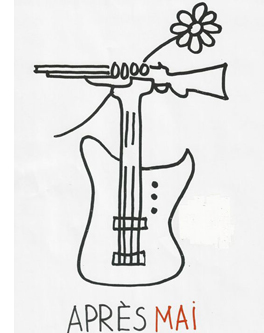 The poles come to be represented by two young women—the wealthy and ethereal Laure for whom he makes his paintings and the more hardheaded leftist rebel Christine, who goes out with him and others on nightly graffiti raids. When Laure leaves for London, Gilles continues his painting while leafleting and splashing slogans on walls, with the occasional Molotov cocktail to spice things up. The copains’ rebellion leads to some harm, but they cling to their ideals.
The poles come to be represented by two young women—the wealthy and ethereal Laure for whom he makes his paintings and the more hardheaded leftist rebel Christine, who goes out with him and others on nightly graffiti raids. When Laure leaves for London, Gilles continues his painting while leafleting and splashing slogans on walls, with the occasional Molotov cocktail to spice things up. The copains’ rebellion leads to some harm, but they cling to their ideals.
When summer comes, Gilles joins a film collective headed to document workers’ struggles in Italy. He encounters the arguments that made me smile in nostalgia: Shouldn’t revolutionary content have a revolutionary form? But how shall we reach the working class if our films are opaque? Assayas, who grew in this period and was repelled by the Maoist dogmatism of Cahiers du cinéma and Cinéthique, evokes these debates to remind us that the counterculture was about art and political change at one and the same time. Something in the Air chronicles a few years when imagination mattered.
After an early, shocking clash of students pounded down in a police riot, the film adopts a more circumspect rhythm, salting its scenes with books, magazines, record albums, and songs of the time. The plot keeps our interest by delaying exposition about the characters’ family lives until rather late. When we learn that Gilles’ father writes scripts for the celebrated Maigret TV series, we’re invited to see his forays into abstract painting as his form of teen rebellion. The plot doesn’t mind straying a bit from Gilles, as when his friend Alain, another aspiring artist, gets caught up in the fervor and pursues a wispy red-haired American dancer.
Characters meet, work or play together, drift apart, re-converge, and eventually settle into something like grown-up life. But at the end, when Gilles has apparently been absorbed into commercial filmmaking in London, he is granted one last vision of one of his Muses, who reaches out for him from the screen of the Electric Cinema.
Analog triumphs as well in The Master. Sitting in the front row of Screen 1 at the TIFF Lightbox (see below), I was astonished at the 70mm image before me. Not a scratch, not a speck of dust, not a streak of chemicals, and no grain. So did it have that cold, gleaming purity that digital is supposed to buy us? Not to my eye. The opening shot of a boat’s wake, which will pop up elsewhere in the movie, was of a sonorous blue and creamy white that seemed utterly filmic. Now we know the way to make movies look fabulous: Shoot them on 65.
The Master, as everybody now knows, centers on Freddie Quell, an explosive WWII vet, and his absoption into a spiritual cult run by the flamboyant Lancaster Dodd. Followers of The Cause are encouraged, through gentle but mind-numbingly repetitious exercises, to probe their minds and reveal their pasts. With the air of a charming rogue in the young Orson Welles mold, Dodd seems the soul of sympathy. But like Freddie he’s capable of bursts of rage, especially when his methods are questioned. Freddie becomes a sidekick because of Dodd’s fondness for his moonshine, while he also serves as a test case for the efficacity of The Cause’s “processing” therapies. If you can get this hard-bitten, borderline-sociopath in touch with his spiritual side, you can help, or fleece, anybody.
Like There Will Be Blood, this movie is primarily a character study. That film gained plot propulsion from Daniel Plainview’s oil projects, but many situations worked primarily to reveal facets of his dazzling self-presentation, his repertoire of strategies for dominating others. Something similar happens with Dodd and the ways he charms his congregation. But here the action is more episodic and the point-of-view attachment is dispersed across two characters. Dodd’s counterbalancing figure, the clenched Freddie, is so difficult to grasp psychologically (at least for me) that the film didn’t seem to build to the sort of dramatic, even grotesque peaks we find in other Anderson projects.
This is also a story about an institution, a quasi-church with a pecking order, rules, and roles. I wanted to know more about how The Cause worked, how it recruited people, and how it garnered money. Laura Dern plays a wealthy patron who lets the group stay in her home, and at one point Dodd is arrested for embezzling from the foundation, but the details of his crime aren’t explained. I also wanted to know more about the group’s doctrine, which seems so vague that Scientology need not worry about being targeted. The rapid-fire catechisms between Dodd and his acolytes are gripping enough, as Q & A dialogue usually is, but what system of beliefs lies behind them? The film seems to fall back on the familiar surrogate father/son dynamics at the center of most Anderson movies, but here filled in less concretely.
In short, after one screening I was left thinking the film was somewhat diffuse and flat. But I need to see it again. I thought better of Boogie Nights and Punch-Drunk Love after re-viewing them, so I look forward to trying to sync up with The Master on another occasion. Alas, in Madison, Wisconsin, I won’t have a 70mm image to entice me.
A bit of each, and both
Luther Price, No. 9 (handmade glass slide, 2012).
Analog imagery came into its own on other occasions, notably during the two programs of experimental films gathered under the heading “Wavelengths.” (At one I spotted Michael Snow in the audience.) Expertly curated by Andréa Picard, these programs assembled some strong, provocative films by several young filmmakers. I won’t review each one here–Michael Sicinski provides very useful commentary on nearly all those I saw—but I must mention the striking slide show that served as an overture one evening. The images didn’t move, exactly, but they might as well have.
Luther Price has been making remarkable films on 8mm and 16mm for several years, and one Wavelength program featured his Sorry Horns, a three-minute mix of abstraction and found footage. The same mix was evident in the procession of stunning handmade glass slides. Many, like the one surmounting today’s entry, evoke early cinema, decay, and clichéd Christian imagery: the wounds of film deterioration become cinema’s stigmata. Even the sprocket holes and soundtracks are invaded by festering particles. Arp-like blobs, pockmarked faces, and spliced and sliced movie frames lie under grids as irregular as medieval leaded windows. This is all gloriously analog.
No less captivating is the new, 100% digital work of an even older master of American avant-garde cinema. In one Wavelengths program Ernie Gehr offered us Departure (2012), a train trip playing on optical illusions in the spirit of Structural Film. We all know what it’s like to sit on a stationary train but then feel, when another train passes, as if we’ve started to move. Gehr translates this kinesthetic illusion into optical terms by filming, first upside down and then in judicious framings, several railbeds rushing by, faster and faster.
These layered ribbons sometimes unfurl right, sometimes left, and sometimes simply hover there as fixed, pulsating strips, all but losing the details of rail and tie and spike. Sometimes the one on top moves right, the grass verge beside it moves left, and the bottom track moves right (or left). This creation of flip-flop movement harks back to Side/Walk/Shuttle (1991) and to Gehr’s 1974 exercise in traffic abstraction Shift, which filmed patterns of commuter traffic from a very high angle.
Accompanying Departure was one of nineteen pieces in Gehr’s Auto-Collider series. Most of them contain some recognizable imagery, Gehr explains, but not number XV, the one we saw. In a sense the distilled essence of Departure, that film’s whooshing planes become vibrant, and vibrating, stacks of bold color, a bit like Daniel Buren in a joyous mood.
How did Gehr create the gorgeous Auto-Collider images? He declined to explain. Kristin suggested a plausible means to me, but I’m keeping quiet. In the analog age, when new methods of abstraction required a lot of sweat equity, filmmakers freely explained their painstaking work with lenses, light, and optical printers. But digital video practice flattens the learning curve. Powerful discoveries like Gehr’s or Phil Solomon’s are very easily replicated without much time, toil, or talent. Hell, somebody would make an app for them.
These artists are right to have trade secrets, just as magicians do. We should be satisfied merely to look. What we see reminds us that both analog and digital media harbor possibilities that go beyond the ability to replicate phenomenal reality. Both media can also dazzle us with things we’ve never seen, or imagined.
Digital projection seems to be taking over the festival scene, if TIFF is any indication. Cameron Bailey reports in a tweet that of the 362 films screened, 232 (64%) were in the Digital Cinema Package format and another 79 (21%) were in HDCam. The remainining 51 (15%) were in 16mm, 35mm, and 70mm.
Are the digital items still films? Robert Koehler suggested that maybe we will start calling everything movies. Interestingly, at the Wavelengths screenings, the artists called their artworks (whether on film or on digital video) “pieces.” Me, I still vote for calling films films, even if they’re on video, just as we have books in digital formats (such as, oh, I don’t know, this one). For me, at least these days, a film is a moving-image display big or small, whether it’s on film or some other medium. For some purposes we may want to specify further: Just as e-book and graphic novel indicate a platform or a publishing format, TV movie or video clip tells us more about what kind of film we have.
See also my January entry on festival problems with digital projection.
Thanks to Cameron Bailey, Andréa Picard, and their colleagues for enabling my visit to TIFF.
The industry screening of The Master at TIFF. Photo by M. Dargis.
Once more, Mad City movies
Night and the City.
DB here:
It’s been a busy time in Madison, at least for me. KT is in Egypt, peering at shards of statues and documenting earlier Armana excavations. I’m at home, having missed the Hong Kong International Film Festival (doctor’s orders) and wistfully wishing I’d been there for the tribute to Peter Chan Ho-sun (check out Fred Ambroisine’s interview at Twitchfilm) and a chance to see—Don’t say whoa!—Keanu Reeves, who was there with Side by Side, his new film on digital cinema (snif).
Instead of traveling, I’ve been doing other stuff. There were, and still are, last-minute checks and fixups on the new edition of Film Art. I went to some movies–Star Wars Episode I: The Phantom Menace, The Hunger Games, The Raid: Redemption, Carnage, 21 Jump Street—as well as screenings at our Cinematheque. Late at night I’ve been watching 1940s films for a long-range project. Most frantically, I’ve been working on a little e-book to be finished, I hope, in three weeks. It will be available on this site, ludicrously cheap, you will want one for sure, I bet, well, why not? More about it later.
In the meantime, Madison has hosted some remarkable visits. I’ve already mentioned Lynda Barry’s delightful presentation of Chris Ware and Ivan Brunetti. I must also mention two other dignitaries that illuminated our lives this spring.
 In early March, Tony Rayns (right), cinema’s man-about-Asia, came to pillage our city’s supply of DVDs and, not incidentally, give a lecture. It was his usual fine performance. “The Secret History of Chinese Cinema” took us through a series of unofficial classics stretching back to the 1930s, including Song at Midnight (1937), with its fairly off-putting defacement, and Scenes of City Life (1935), Tony’s candidate for the best unknown Chinese film. It was gratifying to hear him pay homage to Sun Yu, who attended UW’s theatre program long ago. Who knew that the great director of Daybreak (1933) and The Highway (1934) was a Badger?
In early March, Tony Rayns (right), cinema’s man-about-Asia, came to pillage our city’s supply of DVDs and, not incidentally, give a lecture. It was his usual fine performance. “The Secret History of Chinese Cinema” took us through a series of unofficial classics stretching back to the 1930s, including Song at Midnight (1937), with its fairly off-putting defacement, and Scenes of City Life (1935), Tony’s candidate for the best unknown Chinese film. It was gratifying to hear him pay homage to Sun Yu, who attended UW’s theatre program long ago. Who knew that the great director of Daybreak (1933) and The Highway (1934) was a Badger?
More recently, we were visited by Schawn Belston, an old friend who’s Senior Vice-President of Library and Technical Services at Twentieth Century Fox. Our Cinematheque is running a string of Fox restorations, and Schawn brought along a stunning print of the lustrous noir classic Night and the City (Jules Dassin, 1950).
There’s a nifty story behind that print. Schawn and archivist (and Badger) Mike Pogorzelski discovered an original camera negative in the Movietone News vault in Ogdensburg, Utah. When they struck our print (directly from the neg) and showed it to Dassin a few years ago, he wept with pleasure.
Schawn found another version of unknown provenance. On the basis of the first reel, which he screened for us, this seems to be a British version, with a different voice-over narrator, varying footage and cutting patterns, and a lighter, more romantic score. As Schawn pointed out, this plays more slowly and is more of a melodrama than a thriller; it also makes the Richard Widmark character a little more sympathetic, I thought. Nobody has yet discovered why this version was made.
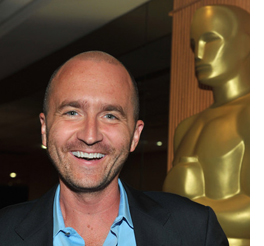 So a mood-drenched noir print, a new slant on postwar film, and a nice little puzzle. On top of those, a talk on the previous day by Schawn, discussing current restoration issues. Naturally the topic turned to the digital conversion, a hot topic on this site and elsewhere. Some basic facts from the inside:
So a mood-drenched noir print, a new slant on postwar film, and a nice little puzzle. On top of those, a talk on the previous day by Schawn, discussing current restoration issues. Naturally the topic turned to the digital conversion, a hot topic on this site and elsewhere. Some basic facts from the inside:
*Lots of filmmakers are still finishing on film, but the plan is to make no prints available to US theatres after 2012. About 300 prints of current titles will still be made for the world market.
*Both Fuji and Kodak are still making film stock, even new emulsions, but the decline in usage will raise prices. A 35mm print now costs $4000, a 70mm print runs $35,000 and up.
*Storage problems are immense. The studio wants to save all the raw footage; in the case of Titanic, that comes to 2.5 million feet. Which version of the film has priority for the shelf? Typically, the longest cut, often the first preview print.
*All studios are still making 35mm negatives for preservation, typically from 4K scans. Ironically, their soundtracks, usually magnetic, can’t match the uncompressed sound of the files on a Digital Cinema Package (DCP).
*”Film is the most stable medium, but the preservation practices for it are the most vulnerable.”
*Nearly all film restoration is digital now, so the best way to show the results is probably digitally. That also makes for standardized presentation and less wear and tear on physical copies.
*Most classic films in a studio library are not available on DCP. If an archive or cinematheque or theatre wants one, there are ways to make on-demand DCPs. But it’s not cheap. A 2K scan runs $40,000; a 4K scan, somewhat more. Schawn opts for 4K because a digital version should be the best possible. It might be the last chance to make one!
*Films stored on digital files must be migrated frequently. Sometimes that’s done through “robotic tape recycling.” But there are problems with the constantly changing formats and standards. The Movietone News library was originally digitized to ID-1, a high-end broadcast tape format from the mid-1990s, so that material will need to be copied to something more current.
*Schawn believes that objective criteria about color, contrast, and other properties need to be balanced with concern for the audience’s experience. By today’s standards, original copies of Gone with the Wind and The Gang’s All Here look surprisingly muted. But to audiences of the time, they probably looked splashy, because viewers saw so few color movies. Restorers and modern viewers have to recognize that perception of a film’s look is comparative, and the terms of the comparison can change.
Schawn’s point was made after his visit with our Cinematheque show of the restored copy of Chad Hanna (Henry King, 1940). For a Technicolor film, it had a surprising amount of solid black, and not just in night scenes. We’re used to “seeing into the dark” via today’s film stocks and digital video formats, and we probably identify Technicolor with the candy-box palette of MGM musicals on DVD. We sometimes forget that chiaroscuro was no less a resource of color film of the 1940s than of black-and-white shooting of the period. A leisurely, charmingly unfocused story with a radiant Linda Darnell (she lights up the dark) and Fonda at his most homespun, Chad Hanna was good in itself and an education in color style circa 1940.
Schawn’s visit, like Tony’s, was informative and plenty of fun. We want to see both again soon.
Up next, as Robert Osborne would say: Some picks for the Wisconsin Film Festival, which launches Wednesday.
Thanks to Jim Healy, Cinematheque programmer, for arranging Schawn’s visit and the Fox retrospective.
Chad Hanna. Not, emphatically not, from 35mm; from Fox Movie Channel.
Pandora’s digital box: From the periphery to the center, or the one of many centers
A laserdisc of The East Is Red; a VCD of Peking Opera Blues.
DB here:
On my first visit to Hong Kong in early 1995, one of my missions was to acquire video copies of all those HK films I wanted to study. The VHS tapes I’d seen in the States had grimy images and pan-and-scan framing. So, armed with my credit card, I focused on a higher-end format, the laserdisc.
For those too young or too sequestered to know this format, I should explain. A laserdisc was twelve inches in diameter, the size of a vinyl LP record, and coated with aluminum. A movie’s image track was inscribed optically on the disc, while the soundtrack was encoded digitally. The disc held about fifty minutes per side in the standard format, but some discs held less because they encoded the film exactly shot for shot. In that encoding system (called CAV), a still video frame was one film frame; the next still was the next actual frame. This was great for a frame-counter like me.
In the US, laserdiscs were for sale, but Hong Kong ones typically weren’t. They were a popular rental format, though, and you could use them to make nice tape copies. Needless to say, neither laserdiscs nor video tapes had copy protection.
As I made the rounds during my trip, I persuaded many shops to sell me some LDs, unfortunately for me at rather high prices. Although rentals remained brisk, the shopkeepers knew that LDs were on the way out. One charming young lady at Laser People, in Causeway Bay, told me of a new format they were waiting for. It would use a blue laser. Was it going to be as good as LD? I asked. She grinned: “Much, much better.”
On the same trip I met the LD’s downmarket cousin.
VCD = Very Curtailed Definition
Video Compact Discs (VCDs) were 4.8 inches across, flimsy, and cheap (US$4 for a legit one, much less for a bootleg). They could be played on computers or dedicated players. On the VCD format I found a copy of Peking Opera Blues, one of my favorite HK movies and one that was elusive on LD. So I bought it, along with a basic player.
The results were pretty feeble. Since the VCD was a CD-ROM, it could carry only about sixty minutes of video, at MPEG-1 compression. So a film was typically squeezed onto two discs. (Sometimes it was trimmed to fit.) Improvements were made over the years, but at a resolution of 352 x 240 pixels, the picture quality was hardly better than VHS tape. In a way, the image was more annoying than VHS because it tended to go very blocky and jerky. Some VCDs were letterboxed, but that compromised picture quality even more, since there were fewer lines devoted to the image.
Want some measure? Just above you find a VCD image from Peking Opera Blues, compared with an image copied (on photographic film) from a 35mm print. Sandwiched between the two, just for fun, is a frame grab from a recent Hong Kong DVD. (For more on these images, see the end of this entry.)
Debuting in 1993, the VCD was the answer to a film pirate’s prayers. VHS bootlegs degraded with each generation of copying, but digital video enabled every copy to be identical to the source disc. The pressing plants that manufactured music CDs could pump out VCDs en masse. By 1998 China had over 500 VCD companies and produced twenty million players per year. By 2000, players were in about a third of urban households. It became identified with low-end, Asia-centered piracy.
In the early 2000s, I saw boxes of VHS tapes chucked out onto the Hong Kong streets, and films were being released on DVD and VCD simultaneously. Piracy turned to the DVD, with results even more massive than with VCD. The newly affluent Chinese could afford the slightly costlier pirate DVD.
Meanwhile, the clumsy and heavy laserdisc was gone, preserved and on the shelves of fanatical, or just plain stubborn, collectors like me. The arrival of affordable DVD players in China in 1999 somewhat cut the interest in VCD, but recent releases today still come out on the junior format. In Hong Kong, VCDs outsell DVDs at a ratio of three to one, and titles older than a year or so go for US$3. VCDs rent more briskly than DVDs, at a cost of less than one dollar US.
Historically, I think, the VCDs played an important role. VCD made commercial movies available on a digital platform aimed at consumers. Invented by big Western companies, it was pushed aside in the rush to make the DVD the international standard. In addition, with the emergence of digital cinema, we might take the VCD as an emblem of a side pf the digital changeover that we often ignore. In surveying the results of opening Pandora’s digital box, we can’t neglect the ways that a triumph of Western research gets turned to ends that undercut the nations and companies originating it.
16mm: Digital exhibition’s dry run
Cinema has a long history of repurposing exhibition formats. A striking example is 16mm film. Invented by Eastman Kodak in 1923, 16 was suited to amateur moviemakers and news photography. Since the stock was non-flammable, 16mm films could safely be exhibited at home, in schools, in public meeting places, and in the newsreel theatres that sprang up during the 1930s and 1940s. The format was also used in screenings for the armed services. After the war, schools and community centers bought 16mm projectors, many from military surplus. My college film society had a pairs of 16mm JANs (Joint Army-Navy) machines, hulks that look like they could survive a torpedo attack. (See above.)
Throughout the 1950s and 1960s, no public school was complete without 16mm projectors for screening educational movies, cartoons, and uplifting Hollywood features. At the same time, local TV stations broadcast from 16mm prints bought from the studios. These prints became sought-after by collectors, a group whose membership expanded with the rise of 16. The format became the standard for independent and experimental filmmaking, of course, but we tend to forget that it was also the bedrock of nontheatrical exhibition. In those days, Audio-Brandon, Contemporary Films, Janus, and other companies could actually make money circulating 16mm films.
For the US and Western Europe, with few exceptions, 35mm was the standard theatrical format, but other countries were more adaptable. The data on 16mm penetration of theatrical markets are very sketchy. (See the end of this post for more information.) Still, we have some bits of evidence. In 1961, Hungary reported having over 3600 16mm installations, as opposed to 803 35mm ones. In the same year, Romania claimed only 462 35mm screens and over 3100 in 16mm.
It seems that sectors of Asia relied heavily on 16mm. As late as the 1980s, India reported over 4500 16mm installations (as opposed to 8221 35mm venues) and Korea claimed nearly 400 (significantly more than its 280 35mm screens). The proportions are probably higher in countries like Thailand and the Philippines, where commercial entertainment films were made in 16mm.
With the expansion of 16mm, a format aimed for home, school, church, and other specialty situations was repurposed for a general public. “Nontheatrical” became theatrical.
The same thing happened, more clandestinely, with videotape after the 1970s. In large cities throughout Asia you could buy or rent bootleg VHS copies of Hong Kong and Indian movies. And there was no restraint on where you could show them. Throughout what was still called the Third World, video copies were exhibited in public venues, from town squares and pubic halls and to tour buses and work sites. Asian cities boasted “video parlors” and “video clubs” and “MTV parlors,” where friends could assemble in small rooms to drink, snack, flirt, and watch a movie, often a pirated Hollywood one.
This unofficial exhibition circuit is acknowledged in the warning that preceded many videos circulated in Asia.
The copyright proprietor has licensed the film (including its soundtrack) comprised in this Video Disc (including Laser Disc) for private home use only. All other rights are reserved. The definition of private home use excludes the use of this Video Disc at locations such as clubs, coaches, hospitals, hotels, motels, oil rigs, prisons, and schools.
Which is the same as admitting that tapes and discs were widely shown in clubs, coaches, hospitals, oil rigs, and other venues.
Much more recently, this “peripheral repurposing” of home technology for public use was taken to its logical conclusion in Nigeria. In 1992, local filmmakers began making VHS films for direct sales to customers. The market expanded with the rise of digital technology, and by 2008 production companies issued dozens of new releases on VCD and DVD each week. A few single-screen and multiplex facilities have been built to show Hollywood films on 35mm, but local movies are still largely screened at home and in informal public venues like restaurants and video halls using TV monitors rather than projectors. A $200 million dollar film industry emerged from technology designed for nontheatrical exhibition.
Overshoot and good enough
A stall selling Thai VCDs in Kowloon City, Hong Kong; from CNN Go.
The VCD fit smoothly into this pattern of low-end distribution and exhibition. But that wasn’t what Western firms had in mind when they invented the digital disc.
In 1993, JVC, Sony, and Philips created the Video CD. A year later the Hollywood majors announced that they would back a single standard for high-quality digital video. The companies laid down demands as to length (135 minutes per side), picture quality (better than laserdisc), compatability with high-quality audio systems, and, among other criteria, content protection. As usual, two major rivals emerged, but they were reconciled. Patents were pooled, and after more wrangling about copy protection the DVD more or less as we know it made its debut at the end of 1997. After more fixes, the format took off in 1999, aided in no small measure by the DVD release of The Matrix.
It seems to me that Western firms’ concentration on the DVD and the sidelining of the VCD exemplify what management analysts have come to call “overshoot.” In the theory of disruptive technologies pioneered by Clayton Christensen, established firms aim to sustain an existing technology, either through incremental improvements or radical innovations. As the technology improves, these sustaining firms target the upper end of the market. Thus Eastman Kodak strove to improve its film stocks to satisfy and win the approval of the world’s top cinematographers. Likewise, Sony and other firms collaborated to create the DVD as an improvement on broadcast video, VHS, and laserdisc.
But in the process they left lower-end markets behind. Entrenched sustaining technology tends to be complicated, inconvenient, and expensive. Christensen posits that the big firms’ overshoot often leave space for firms that develop technology that is cheap, convenient, and “good enough” for what might be a very big segment of purchasers. To the professional eye, VHS was inferior to Beta tape and laserdisc, but for most consumers that tape format was good enough. Then DVD proved more convenient—smaller, more portable, easier to use—and of noticeably better quality. Experts knew that the DVD was still a compromise format, especially compared to 35mm, but for consumers it was good enough.
Overshoot encouraged the spread of the VCD. Concentrating on the DVD and its MPEG-2 protocol, Sony and its co-developers licensed the downmarket format to Asian companies. It was clear that the Chinese market, massive though it was, couldn’t afford DVD players and discs. (In 2000, China’s per capita income was about $1500; a cheap DVD player cost about $200.) But local entrepreneurs rushed to expand the low end of the market. Shujen Wang, in her very informative book Framing Piracy: Globalization and Film Distribution in Greater China, explains that it was easy for Chinese manufacturers to convert audio CD players into VCD players, thereby undercutting the imported models. By 2000, a China-made VCD player cost $30. As a further incentive, some makers included up to 100 free VCDs with purchase of a player.
Millions of players were sold in the mid-1990s, and many were installed in what Variety called “illegal video projection rooms that had screened pirated videos and movies not previously shown in China.” By 1994 there were more than 150,000 public video venues showing tape, laserdisc, and VCDs in the mainland. The following year, piracy was reckoned at a stunning 100% of the market.
Probably Western companies couldn’t have satisfied the market in Asia; local manufacturers, distributors, and retail outlets were needed to make the sales happen. So it probably wasn’t simple neglect that made VCD a de facto regional standard. Nonetheless, the VCD became a disruptive technology. For Asian consumers, laserdiscs were too expensive, VHS was comparatively inconvenient, and digital discs and players suddenly became much cheaper. And with so many movies, mostly illegal, available on the format, the buyer’s and renter’s choice was simple.
VCD was good enough–not just for private consumption but for public exhibition. Once film exhibition on tape had become widespread, the VCD made that practice far more feasible. It provided something like the world’s first “digital cinema” experience.
I’m not competent to trace the VCD’s fortunes in other countries, although it proved popular in India and Latin America. In cities and towns, entrepreneurs set up “electronic cinemas”–that is, video parlors or auditoriums screening discs, usually pirated, to paying audiences. A 1999 report in Variety Deal Memo notes:
Electronic cinema is nothing new in emerging countries with dilapidated or non-existent conventional film projection cinema infrastructure. Small-scale mobile electronic cinemas have set up in small towns for years. . . . Cinetransfer International, for example, offered rural areas in Mexico electronically-screened Mighty Joe Young, A Bug’s Life, The Water Boy, and other films over the years.
Once again, the nontheatrical becomes theatrical, but this time aided by digital technology.
Good enough is better than what we had?
From the rise of the VCD and later the DVD, it’s only a short step to digital exhibition as the West might recognize it. Again, Asia played a key role. Initially, the Western digital cinema projection standard was 1.3K resolution (1280 x 1024 pixels). This became a bone of contention. A Variety article from 2002 asks the disruptive-technology question: “How good a picture is good enough to replace film?”
One end of the spectrum says, ‘Let’s do it now. This is good enough,” says Charles S. Swartz exec director and CEO of USC’s Entertainment Technology Center, which tests digital cinema systems. “At the other end, they’re figuring out the theoretical best we can do and want to hold off.”
While filmmakers in the West debated whether 2K was good enough, exhibitors in developing countries didn’t hold off. In Brazil, small cinemas and chains began adopting 1.3K projection. In India, UFO Moviez and E-City Digital installed low-resolution projection systems in hundreds of theatres, often fed by satellite. Many local observers considered these video displays worthwhile improvements on the battered prints and faded arc-lamps that were staples of most village screenings. Now good enough was better than what went before.
Through the early 2000s, China and the US led the world in digital screens, most on the 1.3K format. The US leaped ahead in 2005, when the Digital Cinema Initiatives standardized 2K resolution. But China will pick up velocity because it’s opening new screens daily. From 2009 to 2010, China leaped from 1788 D-screens to 7920. At the current rate China is opening five new screens each day. You will not, I expect, find a piece of 35mm film in any of them.
In China and India, despite some movement toward 2K projection, the “good enough” strategy persists. Many domestically made Chinese films are released in 1.3K versions, and some are even shot in .8K (1024 x 768 resolution). These can’t be encrypted, and so pirates are making the most of the situation. Even television channels show pirated copies of local movies. And India’s major supplier of digital projection, UFO, works with the MPEG-4 codec used in Blu-ray. This has caused complaints from viewers, but the company’s managing director claims, “In a market with ticket prices averaging between Rs 10-50 [US$.20-$1.00], there is no way DCI standards will take off in India.”
It’s worth remembering,then, that movie viewing on the “periphery” was digital before digital was cool. The swift rise of digital exhibition in China, India, and other major markets has led Hollywood down the same path. You might recall the techno-nerd’s prophetic line in David Byrne’s True Stories: “The world is changing. And this is the center of it right now. Or the one of many centers.”
Much of the information above comes from the indispensable IHS Screen Digest. Other sources, not available online as far as I know, are “Electronic projection rollout excites, worries cinema industry as cost, quality, retrofit issues loom,” Variety Deal Memo (5 July 1999), 5-8, and “Country Profile: China,” Variety Deal Memo (11 October 1999), 5-8. I’ve mentioned Shujen Wang’s valuable book in the text, but go here for her 2003 paper on digital piracy in China.
See also Hu Ke, “The Influence of Hong Kong Cinema on Mainland China (1980-1996),” in Fifty Years of Electric Shadows, ed. Law Kar (Hong Kong International Film Festival, 1997), 164-178, and Darrell William Davis and Emilie Y. Y. Yeh, “VCD as Programmatic Technology: Japanese Television Drama in Hong Kong,” in Feeling Asian Modernities, ed. Koichi Iwabuchi (Hong Kong University Press, 2004), 227-247. A Google Reader version of the latter is available here. In Playing to the World’s Biggest Audience: The Globalization of Chinese Film and TV, Michael Curtin goes beyond technology and analyzes other market forces affecting VCD.
For basic historical and technical information on digital formats I always turn to Jim Taylor, Mark R. Johnson, and Charles G. Crawford, DVD Demystified, 3rd ed. (McGraw-Hill, 2006). Useful reports on the progress of VCD appeared in The Economist here and here. I talk a bit about the rise of digital exhibition in China and Hong Kong in Planet Hong Kong, available here. For background on current VCD trends I’m grateful to a friend in Hong Kong who wishes to remain anonymous.
My comparison of VCD, DVD, and 35mm isn’t entirely fair to the digital formats. Frame grabs tend to look worse than an image displayed on a video monitor, and an HDMI display of the VCD and DVD improves them. Moreover, the Hong Kong DVD isn’t particularly well-authored. A Blu-ray of Peking Opera Blues that I’ve ordered hasn’t yet arrived, so I will update this entry with a frame from that when I can. Finally, my 35mm frame enlargement is a bit too warm and could use some adjusting. But to keep comparison reasonable, I didn’t apply Photoshop to any of the images shown here.
It’s hard to know how widely 16mm film was exhibited commercially around the world, but some indications are given in Statistics on Film and Cinema 1955-1977 (Paris: Unesco, 1981) and various editions of the UNESCO Statistical Yearbook. A pleasant video devoted to JAN 16mm projectors is here; I grabbed a shot from that video above, so thanks to maynardcat for posting the footage.
Why are oil rigs singled out as targets of pirate screenings? My guess: Many Asians emigrated to work on oil extraction throughout Northern Europe and the Middle East, and it wouldn’t be far-fetched to assume that videos were screened for them on site. If anyone reading this can confirm, deny, or nuance, please correspond.
Clayton M. Christensen’s influential formulation of the theory of disruptive technologies is in The Innovator’s Dilemma (orig. 1997). Thanks to Jim Cortada for discussing these ideas with me. Volume 2 of Jim’s Digital Hand trilogy remains the best guide to how computers transformed the media landscape.
“Things fall apart. It’s scientific.” True Stories (1986).












